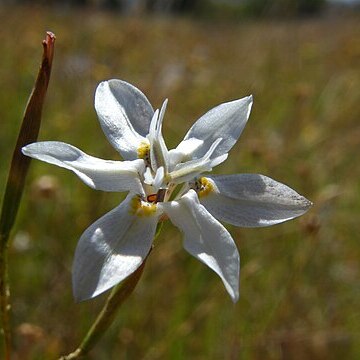Seasonal perennials with tunicate corms. Leaves few-several, the lower 2-3 entirely sheathing and membranous (cataphylls); foliage leaves usually bifacial and channelled, sometimes terete, 1-several, inserted on the lower part of the stem, cauline leaves shorter or entirely sheathing and bract-like. Stem simple or branched (entirely subterranean in some South African SPECIES). Inflorescences rhipidia (umbellate flower-clusters), single per branch or sometimes crowded terminally, each enclosed in a pair of opposed leafy bracts (spathes) concealing the buds. Flowers Iris-like, radially symmetric, usually pedicellate, borne serially, usually blue or yellow with contrasting nectar guides on the outer tepals. Tepals free (rarely united), the outer larger and strongly clawed, the limbs spreading to reflexed, the inner often erect, or spreading. Filaments partly to completely united around the style; anthers appressed to the style-branches. Style filiform below, dividing into 3 flat, usually petaloid branches, these diverging and usually forked apically into 2 crests (crests occasionally lacking); stigma transverse and abaxial below the crests. Capsules globose to cylindric. Seeds numerous, rounded, angular or discoid.
Perennial herbs with annual leaves and flowers. Corm globose, pointed; tunic hard, netted. Leaves 1 to several, basal or near-basal, linear, bifacial, channelled. Scape erect, often branched, with reduced sheathing bracts at nodes. Rhipidia terminal, few-flowered. Spathes acuminate, herbaceous; inner spathe longer. Sepals and petals free, entire, sub-equal; claws either long and widely cupped or short and erect; lamina spreading. Stamens monadelphous; filaments almost completely connate; anthers oblong-linear, appressed to style branches. Ovary oblong-linear; style trifid above filament tube; branches flattened, oblong with broad stigmas and minute paired crests or shortly bilobed with minute terminal stigmas. Capsule cylindrical, usually exserted. Seeds numerous, angular, brown.
Small perennial herbs with annual leaves and flowers. Corm globose; tunic of netted fibres. Stem underground at flowering time, the basal leaves and sessile inflorescence forming a low tuft. Leaves numerous, flat or channelled to terete with broad sheathing bases. Flowers solitary, erect, sessile within 2 herbaceous spathes. Sepals and petals equal to sub-equal, spreading; tube long, cylindrical, widened at apex. Stamens monadelphous, inserted in tube; anthers basifixed, erect, oblong. Ovary globose; style terete, slender, with 3 short, broad stigmatic lobes exceeding or appressed to anthers; stigmas along edges of lobes. Capsule ovoid, sub-membranous, enclosed by spathes. Seeds numerous, angular.
Perennial herbs with annual leaves and flowers. Corm globose; tunic fibrous. Basal leaves 1 to few, linear, bifacial, channelled. Scape erect, few-branched, with numerous sheathing bracts. Rhipidia numerous, the lateral ones sessile, several-flowered. Spathes herbaceous, the inner longer. Sepals and petals sub-equal, free and shortly clawed or rarely connate in a tube at base. Stamens monadelphous; anthers linear-lanceolate, erect. Ovary cylindrical to clavate; style short, deeply trifid, the branches deeply bifid, forming 6 filiform arms each with a minute apical stigma. Capsule cylindrical to clavate. Seeds numerous, angular, brown.
Leaves several to few, the lower 2–3 entirely sheathing and membranous (cataphylls); foliage leaves 1-several, inserted on the lower part of the stem, usually bifacial and channelled, sometimes terete; cauline leaves shorter or entirely sheathing and bract-like.
Inflorescence(s) composed of rhipidia (umbellate flower clusters); rhipidia single per branch or occasionally crowded terminally, each enclosed in a pair of opposed leafy bracts (spathes) concealing the buds.
Style filiform below, dividing into 3 flat usually petaloid branches, these diverging and usually forked apically into 2 crests (crests occasionally lacking), stigma transverse and abaxial below the crests.
Flowers Iris-like, usually blue or yellow with contrasting nectar guides on the outer tepals, radially symmetrical, usually pedicellate, borne serially.
Tepals free (rarely united); the outer larger and strongly clawed with limbs spreading to reflexed; the inner often erect, or spreading.
Filaments partly to completely united around the style (free in some South African species), anthers appressed to the style branches.
Stem simple or branched (entirely subterranean in some South African species).
Perennial herbs with tunicate corms, aerial parts dying back annually.
Seeds numerous, rounded, angular or discoid.
Capsules globose to cylindric.

